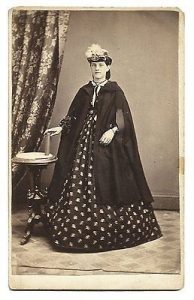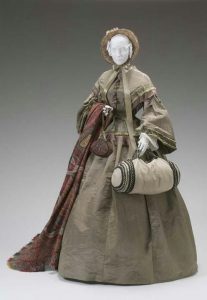Railroads – Her Journey: Ladies Traveling In Mid-19th Century America

The Civil War gave women reasons to travel like they had never had before. Some refugeed away from the armies. Others journeyed to be with loved ones in military camps or hospitals. Others packed their trunks, stretched society’s traditional feminine sphere, and embarked on journeys that would take them into hospital work, fundraising, or other patriotic missions. Unlike traveling by stage or wagon, a woman could board a train in her own community and (theoretically) arrive at her destination in a few hours or days with a few train changes between.
However, traveling by railroad offered its own unique challenges for women in mid-19th Century America. Everyone experienced the thrills and trials of train journeys – rattling, hard seats, limited dining options, limited facilities, etc. – but women had those traveling unpleasantries and other difficulties. Fashion, baggage, propriety, and practicality dictated aspects of her journey – each creating a uniquely different experience from the civilian men or soldiers who rode the rails.
A proper lady wore certain clothes – “traveling dresses” – when she went on journeys. One fashion publication from the era detailed some of the dress’s characteristics. First, the clothing was crafted from subtle, dull colors; a lady did not need to draw attention to herself. One fashion advisor suggested gray fabrics with black, green, or deep magenta accents and trim. Second, a lady had to consider the length of her gown: the hem should clear (be off) the ground to avoid tripping. Third, traveling dresses’ bodices modestly covered the woman to her neck, like other day bodices. What was appropriate in a ballroom was not appropriate at the train station or in the railway cars. Fourth, a traveling dress might have lots of hidden pockets which would be useful for stashing tickets, a handkerchief, love letters, gloves, children’s toys, etc. etc. Fifth, lady travelers were encouraged to use good sense, avoiding lavish trimmings, long ribbons, large hoops, voluminous petticoats, and ruffles, even though this was not always reflected in the fashion plates of the day. Essentially, a lady’s travelling dress would have been plainer and practical – pretty, but unlike to attract unwanted attentions from other passengers.
Baggage. Trunks, carpetbaggers, hatboxes, handbags. Through the centuries, women have needed (or wanted) to take many possessions with them on trips. As one researcher pointed out, the Corps of Discovery crossed the North American continent in 1803 with basically a few packs, guns, and the clothes they wore, but by 1848, the men crossing the plains with their wives needed wagons and a wagon train. Louisa May Alcott sarcastically described packing “my ‘go-abroady’ possessions…danced on the lids till they shut” – poking fun at the female propensity to take too much when traveling. Once a lady had her stuffed baggage ready to go, a gentleman – family, friend, hired-man, or slave – typically had the “honor” of hoisting, lugging, or pushing her trunk(s) of world possessions to the waiting wagon and seeing it off to the train station!

For some time, propriety dictated that a woman should not travel alone, though by the Civil War that restriction was lessening in some parts of the country. Still, dangers – real and imagined – lurked, and the idealized woman was supposed to be protected. Father, brother, husband, cousin, other male relation, or minister might properly escort a lady on her journey, looking after her heavy baggage, purchasing the tickets, guiding her through train stations, providing a shoulder to sleep on, and guarding her from pickpockets and other rough rogues. (Woe to the man who traveled with a lady who had not taken heed to wear practical, narrow skirts! Her dress would overflow the railroad seat…onto his lap.)
Before raising cries of “patriarchy” against the societal view that women should not travel alone, consider the difficulties and dangers of travel in mid-19th Century America. Loading, ticketing, and looking after baggage could be a full-time job; one that would not be particularly easy for a lady, even in practical fashion of the day. There was safety for the woman traveling with a responsible man, and someone solve the problems when they missed a train or needed to find a meal in an unfamiliar place. Also – probably to the gentleman’s dissatisfaction – there was also the possibility that she would have someone else to blame for lost baggage, missed trains, and all the other trials of travels.
Finally, to keep these societal views and norms into perspective, consider practicality and circumstance. The Civil War gave woman a reason and an opportunity to travel. They usually preferred to travel with male protection, but there are cases where women got on trains and headed for their next destination. Sometimes, it simply wasn’t practical or safe to wait to follow the rules. Even for the majority of women who made their journeys in traveling dresses and with protection, the idea of women traveling for “business” or with a purpose beyond visiting family, going shopping, to taking a “wedding tour” (honeymoon) was rather revolutionary.
Suddenly, women boarded trains to escape approaching armies, pushing and shoving their own bags and boxes of belongings. Ladies clutched tickets and wished the clattering wheels would move faster to take them to their sick, injured, or dying loved ones. They carefully maneuvered their skirts to hurry into the train to bring aid to battlefields, either as independent nurses or nurses with different relief organizations. Sometimes, they made the long journey to find a grave or bring home a coffin with the endless rolling wheels making a monotonous dirge for grief.

Lousia May Alcott captured some of the “wild” adventure awaiting the Civil War women who headed for the train station in her writing Hospital Sketches. Though probably exaggerated and certainly written for entertainment over accuracy, her account still breathes the idea of liberating freedom opened by the conflict and the railroads:
When the engine screeched “Here we are,” I clutched my escort [to the station] in a fervent embrace, and skipped into the car with as blithe a farewell as if going on a bridal-tour – though I believe brides don’t usually wear cavernous black bonnets and fuzzy brown coats, with a hair-brush, a pair of rubber, two books, and a bag of gingerbread distorting the pockets of the same. If I thought that any one would believe it, I’d boldly state that I slept from C. [Concord] to B. [Boston], which would simplify matters immensely; gut as I know they wouldn’t, I’ll confess that the head under the funereal coal-hod fermented with all manner of high thoughts and heroic purposes “to do or die,” – perhaps both… [In Boston] the next step was to get a free pass to Washington, for I’d no desire to waste my substance on railroad companies when “the boys” needed even a spinster’s mite. A friend of mine had procured such a pass, and I was bent on doing likewise, though I had to face the president of the railroad to accomplish it…[i]
The combination of the Civil War and railroad travel gave a woman a level of slightly greater autonomy, allowing her to journey from her home and local community into the wider world beyond with or without a man’s protection. However, the difficulties and dangers of traveling remained, testing and shaping how ladies traveled in war-torn America. Ultimately, her travels and journeys during the Civil War influenced culture, creating a stronger, yet still feminine, image for American ladies that would play an important role in the saga of women, travel, and creating new cities in the West during the post-war years.
Sources
[i] Louisa May Alcott, Hospital Sketches

Concerned by a letter received from her husband at the end of March 1862, Ann Wallace quickly arranged to travel from Ottawa to Cairo, Illinois, and organized for a family friend to act as her escort. When the family friend became unavailable, a mutual friend (Chaplain of the 20th Illinois Infantry) filled the role; and Mrs. Wallace arranged for another family friend, Judge Caton, to telegraph ahead to Cairo and inform the military authorities there she was on her way.
Ann Wallace and her party rode the Illinois Central from La Salle, all the way to Cairo. The commander of that military transportation hub (General Strong) was away, so his deputy issued the pass, allowing Mrs. Wallace and her escort to proceed south, to visit her husband (who was part of General U.S. Grant’s build-up of forces on the Tennessee River, acting as division commander.) Mrs. Wallace boarded the steamer, Minnehaha, which also carried a thousand men belonging to the 15th Iowa Infantry; and the Adjutant of that regiment, Captain Belknap, assisted in getting Mrs. Wallace and her luggage installed in the Ladies’ Cabin.
It required two days for the steamer to reach Savannah, Tennessee. Upon arrival, Ann Wallace presented her pass to General Grant, who permitted her to continue her voyage south. The Minnehaha nosed into Pittsburg Landing just before sunrise on April 6th …almost at the same moment a smattering of picket firing erupted into the Battle of Shiloh. [The full story to be found in “Life and Letters of General WHL Wallace” (1909) pp.184 – 7.] https://archive.org/details/lifelettgeneral00wallrich/page/n7